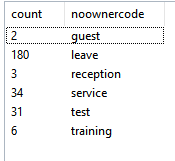Dashboard Components
Introduction
The following section details the available components and variations for use in dashboard and how to configure them:
- Tables
- Indicators (gauge or numeric)
- Basic charts ( bars, horizontal bars, pies, and doughnuts)
- Indicator groups ( gauge, numeric and rows)
- Multi-series charts ( bars and horizontal bars, stacked or side by side series)
- Historical charts (single or multi-series, bar, line and stacked areas )
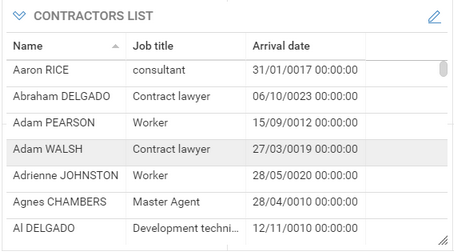
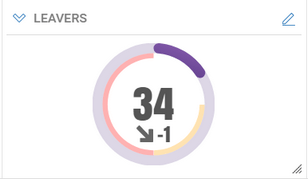
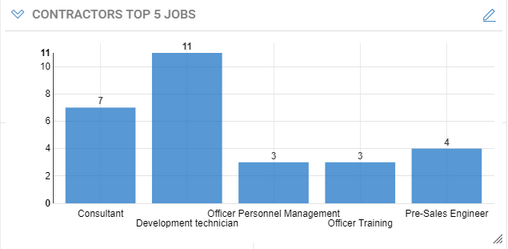


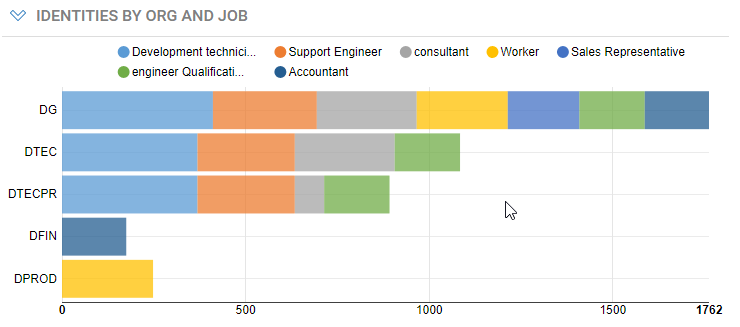
Data Management in Components
Except for indicators, dashboards components determine the data to display based on the combination of two factors:
- Search Rule : determines which are the ledger entities (identities, accounts, etc.) involved in the component
- Data View : determine what parts or computations of the entities retrieved from the search to display.
Depending on the component, this could be:
- Table: selection of attributes
- Chart : aggregated attributes as the values, and attributes as the categories / series of the chart
For indicators and indicator groups, only search rules are used, and the count of entities from the search will make the value to display.
Both search rules and data views can have parameters (see below for details).
Component Configuration
The following pages detail the configuration of each of the components:
Table Component Indicator Component Basic Chart Component Indicator Groups Multi series charts components Single series history charts Multi-series history chart
Don't forget to Save the dashboard when you are satisfied with the arrangement of components, or Discard changes to revert to the previous layout.
Search Rules Parameters
Search rules used in dashboards Tables, Charts and Gauges may have parameters. These are called secondary parameters as opposed to the dashboard's main parameters.
Rule parameters must be used to filter the entities that are displayed or accounted for in the widget (the widget's scope).
These secondary parameters are configured by clicking the Params... button.
This opens the Edit Rule Parameters dialog box which allow to define values for each of the rule parameters.
For each rule secondary parameter, you can set the parameter Source and Value.
- Value : the rule parameter value is a fixed value that must set at design-time (typed or selected from a list of possible values)
- Dashboard Parameter : the rule parameter value will be taken from one of the dashboard's main parameters runtime values
- User Attributes : the rule parameter will take its value from one of the currently connected user attributes
You can also select None as the source, to leave the parameter empty, if it's not mandatory.
See Secondary Parameter Configuration for detailed explanations on the different sources.
Data View Parameters
Views used in dashboards' tables and charts may have parameters. These are called secondary parameters as opposed to the dashboard's main parameters.
View parameters must be used to filter secondary entities or information retrieved by the widget's view only, to ensure optimal execution performance. Consider for example, a table that displays accounts and groups the accounts belong to, for a given repository. Here the main entity is the account, and should be filtered by its repository in the table's rule. The groups are secondary entities and should be filtered using view parameters. Using view parameters to filter the main widget's entity (i.e. the search rule's entity) in the view or both in the rule and in the view may result in slow downs.
Table Component
The table component displays information from the Identity Ledger in columns and rows. The table can be re-sorted by clicking on the headers and can be exported as CSV or Excel file by clicking on the downward arrowhead icon.

Table Configuration
-
Basic tab : sets the table general characteristics
- Title : Sets the text to be displayed in the table's title bar
- Size : Sets the table's display size, expressed in columns and rows. See Dashboard layout section for more information
-
Search tab : allows to select a rule that will determine the entities from the Identity Ledger that will be in the scope of the component. For example "All active entities", or "Orphaned Accounts".
See dashboard data access components section below to understand what rules are displayed and how to add your own.
- Search on : Allows to select the kind of entities to be displayed in the table (Accounts, Application, Asset, Group, Identity, Organization, Permission, Repository or Usage) and will filter the list of rules accordingly.
- Rule : lists and allows to select a rule for the selected entity kind. The rule may have parameters which can be set by clicking the Params... button.
See Rule parameters for details
-
Test allows to check the result of the rule , using the configured parameter values if any.
-
Table View Settings tab: Used to select of the columns to be displayed in the table, and a default sort order for the table rows.
- To select the columns to display do the following:
- Select one of the presentation views. Please note that only views that targets the rule's entity kind will be displayed.
- To select the columns to display do the following:
The View may have parameters which can be set by clicking the Params... button (See View parameters for details)
The list of columns below display the columns that are defined in the view
- Select one or more columns and add them to the table by clicking on the > button
- Your can reorder the columns using the Up and Down buttons
-
Select a item from the Sort By list to define the default sort column order for the table rows, and select Ascending / Descending sort direction.
-
Customization tab: Used to customize column labels, width and alignment.
- To change the width, label or alignment of a column , select the column and click on the Edit... button
- The Auto width corresponds to a 150 pixel width
- You can also set a column width directly by clicking between two column headers and dragging to a specific position. The column width will be preserved when saving the dashboard.
Indicator Component
The Indicator component displays a numerical value as a radial gauge or in text format. The displayed value can be absolute or percentage. The gauge may also display a trend (comparison with the previous timeslot) and thresholds markers if enabled.


Indicator Configuration
-
Basic tab : sets the gauge general characteristics
- Title : Sets the text to be displayed in the component's title bar
- Display as: to set whether the gauge will be displayed as a radial chart or as a text value.
- If Display value as a percentage is checked, you will have to define the maximum value from which the percentage is computed (value / maximum value).
- Style: to define the color scheme for the main gauge dial, either as a flat or gradient color, from a list of available color schemes.
- Size : the size of a gauge cannot be configured. It always covers one cell of the grid layout (1 column and 1 row)
-
Value tab : defines how the displayed value is computed.
The computation consists of two parts:
- Scope of the gauge, that is the entities from the Identity Ledger that will be part of the figure. For example "All active entities", or "Orphaned Accounts".
The scope can be defined in two ways:
- Simple mode : directly select your criteria in free search mode.
- select the entity to search on
- then select your criteria in assisted mode
- Advanced mode : selecting an existing rule from the project.
(See dashboard data access components section below to understand what rules are displayed and how to add your own ones).
- Search on list allows to select the kind of entities to search for (Accounts, Application, Asset, Group, Identity, Organization, Permission, Repository or Usage) and will filter the list of rules accordingly.
- Select Rule lists and allows to select a rule for the selected entity kind. The rule may have parameters which can be set by clicking the Params... button. (See § Rule parameters for details)
-
Click on Test to check the result of the search or selected rule.
-
Aggregation function of the gauge. There are 5 aggregation functions:
- Count : the displayed value will be the number of items returned by the search or rule defined in the scope.
- Sum : the displayed value will be the sum of the numerical attribute selected in the Value attribute menu for all items returned by the search.
The available attributes are either numerical metadata attributes on the entity or default numerical attributes for this concept, as defined in the mashup chart views. If you don't find the attribute you are looking for, you can build you own view and select it in the Advanced mode.
- Average : the displayed value will be the average value of the numerical attribute selected in the Value attribute menu for all items returned by the search.
- Maximum : the displayed value will be the maximum value of the numerical attribute selected in the Value attribute menu for all items returned by the search.
- Minimum : the displayed value will be the minimum value of the numerical attribute selected in the Value attribute menu for all items returned by the search.
-
Maximum Value tab: allows to define a maximum value for computing a percentage value for the gauge.
This tab is only available if Display value as a percentage has been checked
- Select Fixed Value and type in a value, to use a static value as the denominator for the percentage
- Select From another search and value to have the percentage denominator dynamically computed based on another rule, search and aggregation function.
For example to compute the rate of contractors in the company, you would select "contractors" as the main search for the gauge, and "total employees" as the maximum search.

- Trend and evaluation tab
- Check Display trend to display a trend value and icon ( see below for explanations on options and how the trend is computed)
- Check Enable evaluation of value to enable evaluation and coloring of the value depending on thresholds ( red / orange if the value exceeds the thresholds)
- Select High Thresholds / Low Threshold evaluation mode to set how evaluation is computed ( see Threshold evaluation section below, for computation details)
- Enter values for warning threshold and critical thresholds
Displayed Indicator Values
Current main value - the following value will be displayed, depending on the gauge setting:
- if Display as percentage is not checked : current main value
( = count of entities in the main search , for the current time slot) - if Display as percentage is checked : current main value / current maximum value (= count of entities in the main search for the current time slot / maximum value , fixed or count from another rule)
Trend value - the following trend value will be displayed :
- If Display as percentage is not checked: current main value / current maximum value
( = the difference between the count of items of the main search for the current time slot and count of items of the main search, for the previous time slot )
- if Display as percentage is checked: ( current main value / current maximum value) - ( previous main value / previous maximum value)
The previous value used for computing the trend is determined as follows:
- if Use comparison timeslot is checked: use the previous reference timeslot , if there is one, or the previous timeslot if no reference timeslots have been defined.
- if Use comparison timeslot is not checked: always use the previous timeslot and ignore reference timeslots.
Threshold values are expressed as absolute values or percentages, depending on display as percentage option.
Threshold evaluation is computed as follows:
- In High thresholds evaluation mode:
- Value is at critical level if higher or equal than (>=) critical threshold
- Value is at warning level if higher or equal than (>=) warning threshold
- Value is normal, otherwise ( if lower than warning threshold)
- In Low thresholds evaluation mode:
- Value is at critical level if lower than (<=) critical threshold
- Value is at warning level if lower than (<=) warning threshold
- Value is normal, otherwise ( higher than warning threshold)
Basic Chart Components
The chart component displays a set of labelled values as a graphical chart. Four chart types are available: bar , horizontal bar , doughnut and pie.



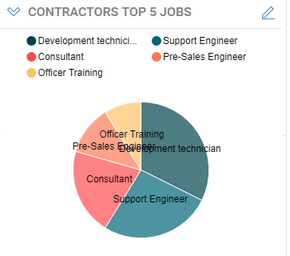
Chart configuration
Tabbed wizard configuration
Basic tab
This page sets the chart general characteristics
- Title : Sets the text to be displayed in the chart's title bar
- Type : defines the type of the chart among the four available types (bar , horizontal bar , doughnut and pie)
- Style : allows to define the color scheme to use for the charts bars or wedges, from a list of available color scheme.
If the number of values in the chart exceeds the number of colors defined in the scheme, colors are cycled.
- Display options: for various chart flags depending on the chart's type
- Show legend : (pie and doughnut charts) allows to display a separate legend above the chart .
- Display series labels inside bars (horizontal bar) : displays the value labels inside the bars, to cope with long labels and screen space, or to the left or bars, for short labels.
- Stagger series labels (bar chart) to display bar labels on two lines.
- Size : Sets the chart's display size, expressed in columns and rows. See Dashboard layout section for more information
Search tab
This page allows to define a free search or select a rule that will determine the entities from the Identity Ledger that will be in the scope of the chart.
For example "All active entities", or "Orphaned Accounts".
The search can be defined in two ways:
- Simple mode : directly select your criteria in free search mode.
- select the entity to search on
- then select your criteria in assisted mode
- click apply button to test the search
- optionally click Advanced to switch to advanced mode.
- Advanced mode : selecting an existing rule from the project.
See dashboard data access components section below to understand what rules are displayed and how to add your own ones.
- Search on list allows to select the kind of entities to search for (Accounts, Application, Asset, Group, Identity, Organization, Permission, Repository or Usage) and will filter the list of rules accordingly.
- Rule : lists and allows to select a rule for the selected entity kind.
- Params... button allows to defines rule parameters if any. (See § Rule parameters for details)
- Test allows to check the result of the rule , using the parameter values if any.
Chart data settings
This page defines chart values, chart category labels, and optional sorting/limiting data options.
There are two ways of defining chart data:
- Simple mode: simply select attributes for value and category from a predefined list that covers common cases:
- Chart value select the attribute to use as a value for chart points. The following attributes are available by default for selection:
- one computed from search aggregate attribute computed by counting items matching the search criteria in each category
- all metadata numerical attributes associated to the chart entity as defined in the project metadata.
- Select Category label from a list of predefined category labels that cover common cases for the chart entity
- Chart value select the attribute to use as a value for chart points. The following attributes are available by default for selection:
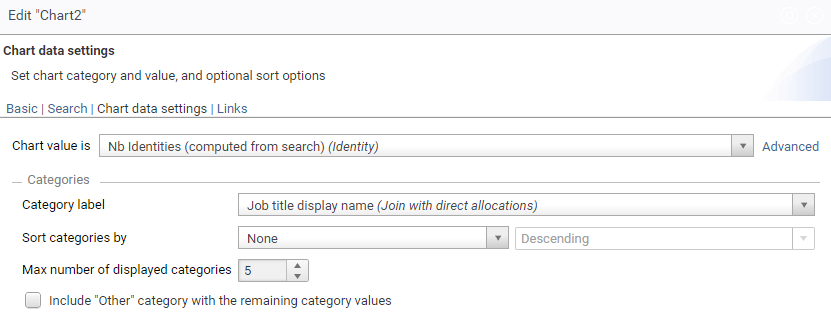
-
Advanced mode : select value and label attribute from a custom-defined view
- View drop down list allows to select the view to produce values and labels for the chart.
Only views that target the same entities ( account, people, organization, etc.) as the selected search rule are displayed.
The selected view may have parameters which can be set by clicking the Params... button (See § View parameters for details) - Chart value : select an attribute from the view to use as the chart value points. Numerical and aggregate attributes from the view are available for selection.
- Select Category label column from the view to use be used as the chart category label
- View drop down list allows to select the view to produce values and labels for the chart.
Only views that target the same entities ( account, people, organization, etc.) as the selected search rule are displayed.
-
You can optionally Sort categories by count value, label or not sorted (natural order)
-
For readability matters, you must limit the number of items in the chart ( default 5, maximum 50)
-
Check Include other category with the remainders to gather the rest of the values into a single category labelled Other.
Indicator Groups
The purpose of Indicator groups is to simplify the layout of numerous inline indicators, and provide a more readable output. Moreover, a new text line layout displays many indicators vertically in a compact manner.
Radial Gauge layout

Text Line layout
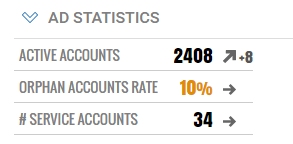
Create an indicator group using the
 icon in the mashup edition toolbar.
icon in the mashup edition toolbar.
Configure Indicator Groups
- Basic tab:
- Title : sets a global title for the indicator group. This title can include parameters
- Display as : selects the type of indicators in the group. All indicators in a group share the same type.
There are three different types : - Radial Gauge : indicators are displayed in a horizontal row of circular gauges - Numeric : indicators are displayed in a horizontal row of numeric indicators - Text line : indicators are displayed in a vertical row of lines of text.
-
Size : Sets the chart's display size, expressed in columns and rows. See Dashboard layout section for more information
-
Indicators tab: allows to add, edit, delete and reorder indicators in the group.
- Add to create a new indicator to the group
- Edit to edit the selected indicator
- Delete : to remove the selected indicator from the group
- Up / Down : to move the selected indicator up and down in the list ( left/right on the display)
For convenience, it's also possible to add, edit and delete indicators directly using icon buttons (you must use the Indicators tab to reorder indicators). Move the mouse over the indicators while editing a dashboard to have the buttons appear.

Multi Series Chart Components
Multi series charts display horizontal or vertical bars charts with more than one series. series bars can be side by side, stacked or stacked to 100%.


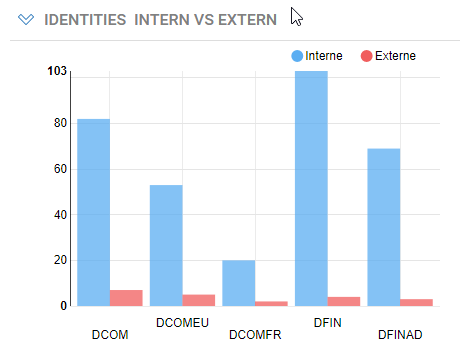
Multi-chart Configuration
- Basic tab : sets the chart general characteristics
- Title : Sets the text to be displayed in the chart's title bar
- Type : defines the type of the chart among the two available types ( bar and horizontal bar**)**
- Style : allows to define the color scheme to use for the charts bars, from a list of available color scheme.
If the number of values in the chart exceeds the number of colors defined in the scheme, colors are cycled.
-
Display options: various chart flags depending on the chart's type
- Show legend : allows to display a separate legend above the chart .
- Stagger series labels ( bar chart) to display bar labels on two lines.
- Grouping mode : how the series bars in each category should be grouped: Side by side , Stacked or Stacked at 100%
-
Size : Sets the chart's display size, expressed in columns and rows. See Dashboard layout section for more information
-
Search tab : allows to select a rule that will determine the entities from the Identity Ledger that will be in the scope of the chart. For example "All active entities", or "Orphaned Accounts".
See dashboard data access components section to understand what rules are displayed and how to add your own ones.
-
Search on list allows to select the kind of entities to search for (Accounts, Application, Asset, Group, Identity, Organization, Permission, Repository or Usage) and will filter the list of rules accordingly.
-
Rule : lists and allows to select a rule for the selected entity kind.
-
Params... button allows to defines rule parameters if any. (See § Rule parameters for details)
-
Test allows to check the result of the rule , using the parameter values if any.
-
Chart data settings : define a source view for the chart values, categories and series, and optional sorting/limiting data options.
- View drop down list allows to select the view to produce values and categories/series labels for the chart.
Only views that target the same entities ( account, people, organization, etc.) as the selected search rule are displayed.
These views must also provide exactly one numerical value.
The selected view may have parameters which can be set by clicking the Params... button (See § View parameters for details)
- Chart value : read/only field automatically set to the single numerical value of the view.
- Categories configuration
- Select Category label column from the view to use be used as the chart category label
- You can optionally Sort categories by value, label or not sorted (natural order).
Sorting by value means the total values of all the series in each category
- For readability matters, you must limit the number of categories in the chart ( default 5, maximum 50)
- Check Include other category with the remainders to gather the rest of the values into a single category labelled Other.

- Series configuration
- Select series label column from the view to use be used as the chart category label
- You can optionally Sort series by value, label or not sorted (natural order).
- For readability matters, you must limit the number of series in the chart ( default 5, maximum 50)
- Check Include other with the remainders to gather the rest of the series into one single series labelled Other.

Notes on Multi-chart Data
The view for a multi series chart must provide values for the chart in the following way:
- Each row of the view provide data for one category and series combination , with at least 3 columns for the category label, the series label and the value. (see example below)
- Additional columns may be needed for linking information (such as internal ids)
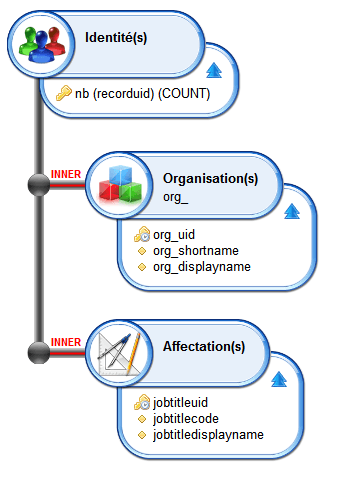

Single series History Charts
History chart display one value evolution over a number of time periods, either as a line or bar chart.

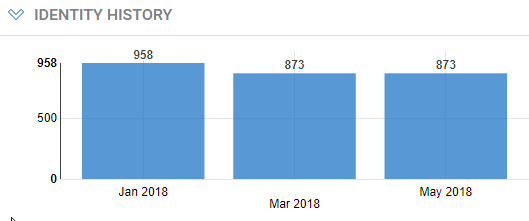
You create a single-series history chart using the
 icon in the dashboard toolbar.
icon in the dashboard toolbar.
Single-series History Chart Configuration
- Basic tab : sets the chart general characteristics
- Title : Sets the text to be displayed in the chart's title bar
- Type : defines the type of the chart among the two available types ( line or bar)
- Style : allows to define the color scheme to use for the charts bars, from a list of available color scheme.
If the number of values in the chart exceeds the number of colors defined in the scheme, colors are cycled.
-
Display options: various chart flags depending on the chart's type
- Show legend : allows to display a separate legend above the chart .
- Stagger series labels ( bar chart) to display bar labels on two lines.
-
Size : Sets the chart's display size, expressed in columns and rows. See Dashboard layout section for more information
-
Search tab : allows to select a rule that will determine the entities from the Identity Ledger that will be in the scope of the chart. For example "All active entities", or "Orphaned Accounts".
See dashboard data access components section to understand what rules are displayed and how to add your own ones.
-
Search on list allows to select the kind of entities to search for (Accounts, Application, Asset, Group, Identity, Organization, Permission, Repository or Usage) and will filter the list of rules accordingly.
-
Rule : lists and allows to select a rule for the selected entity kind.
-
Params... button allows to defines rule parameters if any. (See § Rule parameters for details)
-
Test allows to check the result of the rule , using the parameter values if any.
-
Chart data settings : define a source view for the chart value to display, date formatting and optional sorting/limiting data options.
- View drop down list allows to select the view to produce values for the chart.
Only views that target the same entity ( account, people, organization, etc.) as the selected search rule are displayed.
These views must also provide exactly one numerical value.
The selected view may have parameters which can be set by clicking the Params... button (See § View parameters for details)
- Chart value : read/only field automatically set to the single numerical value column of the view.
- Time slots configuration :
- Date Format : allow to select or type a custom format to use for displaying time slot dates on the x axis. see Formatting Dates section below.
- Max displayed time slots : limits the number of time slots to display. For example, typing 5 will display the last 5 timeslots, including the current one.
- Reference time slots only : displays only the last reference time slots.
This is typically useful when the period of data collection is more frequent than the period of analysis (e.g. daily vs. weekly or monthly).
Time slots can be marked as -Reference- through a post-collect workflow. See How to define and use Reference Timeslots

Date Formatting
You can format dates on the y axis using the following localized tokens:
Token | Description | Example |
|---|---|---|
%a | abbreviated weekday name | Mon |
%A | full weekday name | Monday |
%b | abbreviated month name. | Nov |
%B | full month name. | November |
%d | zero-padded day of the month as a decimal number | 01 for 2018/07/01 |
%e | space-padded day of the month as a decimal number | 1 for 2017/07/01 |
%j | day of the year as a decimal number | |
%m | month as a decimal number | 07 for July |
%U | Sunday-based week of the year as a decimal number | 26 for Sunday 2018/07/01 |
%w | Sunday-based weekday as a decimal number | 0 for Sunday 2018/07/01 |
%W | Monday-based week of the year as a decimal number | 25 for Sunday 2018/07/01 |
%x | the locale's date, such as | 07/01/2018 |
%y | year without century as a decimal number | 18 for 07/01/2018 |
%Y | year with century as a decimal number. | 2018 |
For example, %b - %Y will format 07/01/2018 as Jul - 2018.
You can also select from predefined formats:
- Short date : equivalent to %x
- Month number / Year : equivalent to %m/%y
- Abbreviated month / Year : equivalent to %d-%y
- Month / day : equivalent to %m/%e
Data for Single-series History Chart
The view for a single series history chart must provide only one column with the numerical value to display. related attributes and any link-related attributes. The view must return only one value when executed in the studio.
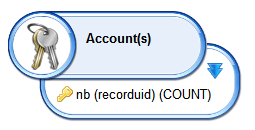

Multi-Series History Chart
History chart display series values evolution over a number of time periods, either as stacked areas, multi-bar or multi-line chart. It could be for example, evolution of #employee per job, #accounts per repository, etc.
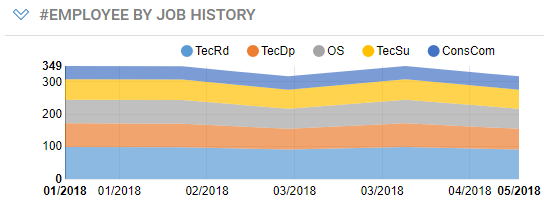
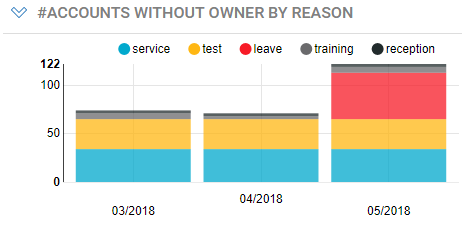
You create a multi-series history chart using the
 icon in the dashboard toolbar.
icon in the dashboard toolbar.
Multi-series History Chart Configuration
- Basic tab : sets the chart general characteristics
- Title : Sets the text to be displayed in the chart's title bar
- Type : defines the type of the chart among the two available types ( line or bar)
- Style : allows to define the color scheme to use for the charts bars, from a list of available color scheme.
If the number of values in the chart exceeds the number of colors defined in the scheme, colors are cycled.
- Display options: various chart flags depending on the chart's type
- Show legend : allows to display a separate legend above the chart .
- Stagger series labels ( bar chart) to display bar labels on two lines.
- Grouping mode : how the series bars in each category should be grouped: Side by side , Stacked or Stacked at 100%.
In line mode, stacked mode display the series as stacked areas, not lines.
-
Size : Sets the chart's display size, expressed in columns and rows. See Dashboard layout section for more information
-
Search tab : allows to select a rule that will determine the entities from the Identity Ledger that will be in the scope of the chart. For example "All active entities", or "Orphaned Accounts".
See dashboard data access components section to understand what rules are displayed and how to add your own ones.
-
Search on list allows to select the kind of entities to search for (Accounts, Application, Asset, Group, Identity, Organization, Permission, Repository or Usage) and will filter the list of rules accordingly.
-
Rule : lists and allows to select a rule for the selected entity kind.
-
Params... button allows to defines rule parameters if any. (See § Rule parameters for details)
-
Test allows to check the result of the rule , using the parameter values if any.
-
Chart data settings : define a source view for the chart values and series to display, date formatting and optional sorting/limiting data options.
- View drop down list allows to select the view to produce values for the chart.
Only views that target the same entity ( account, people, organization, etc.) as the selected search rule are displayed. These views must also provide exactly one numerical value. The selected view may have parameters which can be set by clicking the Params... button (See § View parameters for details)
- Chart value : read/only field automatically set to the single numerical value column of the view.
- Time slots configuration
- Date Format : allow to select or type a custom format to use for displaying time slot dates on the x axis. see Formatting Dates section below.
- Max displayed time slots : limits the number of time slots to display. For example, typing 5 will display the last 5 timeslots, including the current one.
- Reference time slots only : displays only the time slots that are labelled as Reference. This is typical useful when the period of data collection is more frequent than the period of analysis.

- Series configuration:
- Select series label column from the view to be used as the chart series label
- You can optionally Sort series by value, label or not sorted (natural order).
- For readability matters, you must limit the number of series in the chart ( default 5, maximum 50)
- Check Include other with the remainders to gather the rest of the series into one single series labelled Other.
see here for more information on the date formatting
Data for Multi-series History Charts
The view for a multi-series history chart must provide one column with the numerical value to display and one or more columns for the series (series label, series unique id, etc..) It need not contain timeslot related attributes and any link-related attributes. The view must return one row per series.

